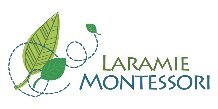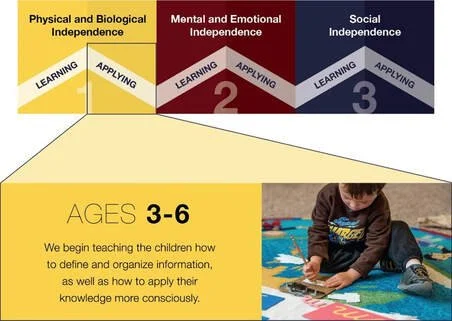Montessori Primary Program
About the Montessori Primary Program
Meet the Child: The Plane of Development
Early Childhood: Ages 3 - 6
The awakening of the unconscious mind marks the transition from toddlerhood to preschool. These young children begin to individuate, moving from generalizations (e.g., all women are “mom”) to specificity (e.g., “my mom”). They seek out social connections in a new way, now interested in developing friendships and working together with others. They begin practicing the social customs they absorbed in their first years. This conscious awareness also introduces greater complexity to the skills they acquired in their first years. Still, like their younger selves, these children thrive from a careful mixture of routine and independence.
Areas of Development
Refinement of coordination and dexterity
The rapid increase in new vocabulary and absorption of new languages
The propensity for order and categorization
Increased concentration for task completion
Increased autonomy and independence
The Curriculum
The 3-hour work cycle is free-flowing and uninterrupted, giving students opportunities to receive lessons from teachers, individually or in small groups. Children choose their materials and work at their pace, taking time for multiple repetitions to practice and build mastery where needed. When they need a break—for a snack, toileting or just to move around—they are allowed to step away from their activities to recharge. After a break, students often return to the same activity to deepen their practice, though they may also move on to receive a new lesson when ready.
Teachers support and encourage continued learning, but young children, with their abundance of energy and confidence, exemplify what it means to have intrinsic motivation. In this age group, children are not yet ready to learn abstractions (e.g., 4+3=7), so they are presented with concrete materials that will support later abstract thinking (e.g., 4 beads and 3 beads together make 7 beads). All materials in our Montessori Primary classrooms are beautifully and intentionally designed to be hands-on with built-in control for error. After the initial presentation of the lesson by the teacher, students can work on their own with the material and still recognize and correct their mistakes, thereby building independence, confidence, and problem-solving skills.
During the Primary Capstone (Kindergarten) year, 5 and 6-year-old students build on their years of experience and take on more advanced materials, including the introduction of abstract concepts. They also rise to the exciting challenge of a leadership role, offering guidance and lessons to younger peers.
Language
Mastery of letters and letter sounds
Word-building, phonics, and writing skills
Early reading skills
Math
Mastery of the decimal (base ten) number system
Understanding of systems of measurement, including time and money
Knowledge and understanding of abstract math concepts, including the four basic mathematical operations
Culture
Biology
Geography
History
Botany
Cultures
Practical Life
Independence around caring for oneself: dressing, tying shoes, etc.
Mealtime: setting places, preparing snacks, washing dishes
Cleaning the environment: straightening shelves, sweeping, scrubbing tables, etc.
Manipulative practice to build hand-eye coordination
Caring for living things in the environment: plants and animals
Supplemental Curriculum
Peace Education
Music and Movement
Sensorial (learning concepts through concrete forms)
Art and Art Appreciation
Sustainability and Mindfulness
Nurturing the Person
Through our Peace Education, Primary students are guided daily with Grace and Courtesy lessons. In addition to teaching children how to practice self-care and hygiene skills (peace comes from within), we teach children how to care for their workspace and materials, as well as the personal space, belongings, and emotional well-being of others. This includes a focus on conflict-resolution techniques which are taught to facilitate healthy and peaceful social interactions. Children also learn how to care for animals, plants, and the environment, building a deeper emotional connection to the world around them.
The children can work collaboratively through group lessons and assist each other when they need help. Kindergarten students are given opportunities to model tasks for the younger children, demonstrating how to complete a lesson and guiding their learning. These moments of leadership develop self-confidence and cement skill mastery.
Hands as Instruments of the Mind
The Primary environment offers children the opportunity to refine the physical skills acquired in their toddler years. Control of hand movements is especially important in the preparation for writing with a pencil grasp, vital for later learning. Thus, the curriculum, particularly Practical Life, offers opportunities to hone hand control through careful transfers from one vessel to another using a variety of tools, such as eyedroppers, spoons, tongs, and pitchers. Additionally, Art and Music fine-tune the hand muscles through the use of specific tools: paintbrushes, beadwork, striking bells, gluing, playing instruments, etc.
Gross motor development, while fairly developed at this age, sharpens and becomes more graceful with conscious practice. A child learns to walk carefully on a line and around a work rug, so as not to disturb another’s work. They carry a pitcher of water without spilling across a busy room.
The Montessori Environment
The Classroom
The Primary classroom belongs to and is cared for by the community. Teachers curate the available lessons with care, preparing them to meet the needs of the children in the environment.
An open layout with child-sized shelves, chairs, and tables allows for easy access to materials and freedom of movement.
Materials are appropriately sized for a young child’s body and hands in order to encourage success in their use.
Materials are organized by subject, and sequenced from simple to complex, to aid discovery, foster order, and encourage growth.
Shelves are sparse so that materials can be easily seen and returned, without overwhelming a child with choices.
Natural light, living plants, and animals, family photos (from children in the classroom), and natural materials create a peaceful and home-like ambiance.
Peace corners for self-regulation (see Nurturing the Person).
School Year Daily Schedule
7:30-8:00: Before the care program.
8:00-11:15: Morning work cycle: Individual and small group lessons, repetition and practice with familiar materials, snack.
11:25-11:55: Outside time and playground.
11:55-12:25: Community Lunch
12:30-1:40: Nap/Rest Time for students aged 3 years to 4 years old. The amount of time for rest depends on the age of the students.
1:40-3:00: Preschool: afternoon work cycle, Specials such as music, art, movement, gardening, and mindfulness depending on the day.
12:15-3:00: Kindergarten: afternoon work cycle, Specials such as P.E., Music, Art, Gardening, Library, Robotics, and Keyboarding depending on the day.
3:00–5:30: After-school care program
While our Primary students are given freedom during morning and afternoon work time to choose their tasks and devote as many repetitions as needed to master the related skills, it is important to remember that this is freedom within limits. Teachers carefully curate the available materials and guide students in their work through individual and group lessons. Over the course of the time a child is in the Primary environment, they have the opportunity to work with and master all of the available materials.
Note: The term “work” in the Montessori environment is used deliberately to elevate and bring import to the great effort the child puts forth. That said, for the child, this often looks like “play.” because this effort is joyful and natural.
The Advantages of Multi-aged Classrooms


